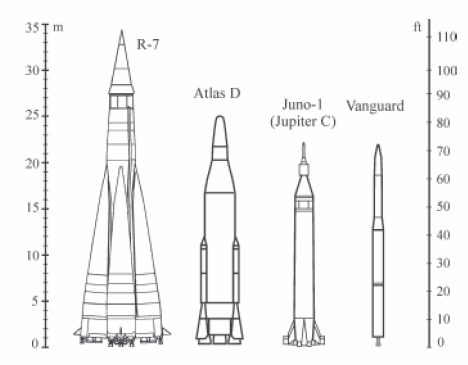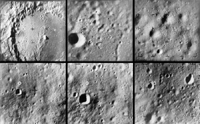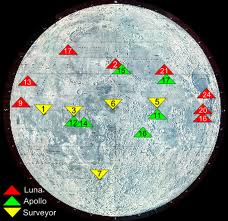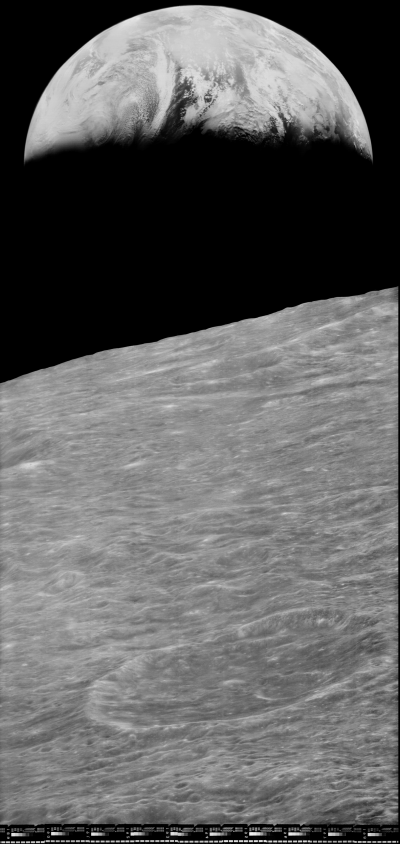From the ashes of Germany’s Second World War V-rocket program, the United States and Soviet Union developed space programs of their own. They did this by bringing the German scientists from Peenemunde to their respective countries along with the factories and remaining rocket inventories.
It should be no surprise that so many of the ideas and technology developments behind the programs of both countries appeared similar in design. While the Soviets managed to achieve the most notable firsts in their space exploration program from the launch of Sputnik to the first lunar landers and orbiters, their American counterparts, with muscle and money, and managed by a single organization NASA, soon caught up.
America Goes Translunar
The United States launched Explorer-1 in January of 1958, almost 4 months after Sputnik-1. Built by the Jet Propulsion Laboratory (JPL) in California, the satellite contained instruments for detecting cosmic rays. The launch vehicle was a direct descendant of the German A-4, renamed the Jupiter-C. Explorer-1 weighed approximately 14 kilograms (30 pounds). Compare that to Sputnik-1 at 83.6 kilograms (183.9 pounds). Could the Americans have launched a satellite the size of Sputnik-1? Not in 1958.

The Soviet R-7 made American rocket boosters look feeble in comparison. The Jupiter-C’s Juno-1 version used in the Explorer-1 launch provided approximately 50,000 kilograms (110,000 pounds) of thrust. The R-7 in comparison with its four rocket engines could deliver 408,000 kilograms (900,000 pounds) of thrust, enough to launch payloads as large as 8,000 kilograms (17,600 pounds). The R-7 was modifiable to be a multi-stage vehicle for translunar flight. None of the American rockets had that capability.
In March 1959, the Americans launched Pioneer-4 using a Juno-2 rocket and for the first time had the thrust capability to push a satellite beyond Earth orbit to an escape velocity that allowed it to pass within 60,000 kilometers (37,000 miles) of the Moon. The Juno-2 payload capability allowed for a 41 kilogram (90 pound) satellite in low-Earth orbit and could boost a 6 kilogram (13 pound) object into translunar flight and ultimately solar orbit.
American Lunar Exploration
In support of President Kennedy’s pursuit of a manned spacecraft landing on the Moon before 1970, the United States developed both the technology for getting there and doing scientific study as well as surveying and photographing the lunar surface. To do this the Americans relied on three missions and spacecraft types, the first called Ranger, the second Surveyor and the third Lunar Orbiter.
Ranger
The Ranger series of spacecraft were missions designed to take close-up images of the Moon’s surface. Ranger spacecraft were built to crash onto the lunar surface while sending images back to Earth until impact. To launch the equipment needed to do this type of mission the Americans required a more powerful rocket than the Juno and Jupiter-C. They chose Atlas as the primary launcher (see picture above) for these missions. Atlas was far more powerful than its predecessors and could place a 327 kilogram (702 pound) payload into lunar trajectory. But early Ranger attempts failed to get beyond Earth orbit because of problems with the rocket’s upper stages. When Ranger-3 launched in January 1962 it was placed in low-Earth orbit before the upper stage rocket engines were successfully restarted to inject the spacecraft into a translunar flight. The spacecraft missed the Moon as did its sister, Ranger-4, in April 1962. Ranger-5 launched in October 1962 relayed pictures of the Moon but missed its target by 725 kilometers (450 miles). In January 1964 Ranger-6 successfully hit the target but failed to transmit pictures of its descent. Finally in July 1964 with Ranger-7, a 362 kilogram (798 pound) satellite, the Americans achieved both impact and pictures. Ranger-8 and Ranger-9 successfully followed in 1965.

In the Ranger program the Americans, like their Soviet rivals, demonstrated that they could provide sufficient payload launch capability to achieve beyond-Earth space flight. They could operate multi-stage rockets that could be restarted in space. They could adjust flight paths, and could operate instrumentation in space and communicate back to Earth.
What remained on the shopping list of technological achievement included powered, controlled descent and soft landing, and orbital insertion capability around a non-Earth space object. These technological achievements were the goals of the other lunar programs that NASA launched after Ranger.
Surveyor
In Surveyor-1, in June 1966, the United States demonstrated a technological breakthrough. Only trailing the Soviet Luna-9 landing by four months, Surveyor-1 provided colour-television camera images of the lunar surface and relayed these back to Earth. Launched by Atlas-Centaur rockets between 1966 and 1968, five of the seven successfully soft-landed on the Moon and transmitted more than 88,000 pictures of their landing sites back to Earth. These sites were to be future landing sites for the Apollo Program. Surveyor-3 and Surveyor-7 included robotic soil scoopers for sampling lunar surface materials. The Surveyor landers from 5 through 7 included chemical analysis equipment and magnetometers to study lunar surface soils.
The Atlas-Centaur rocket could place 5,000 pound payloads into high-Earth orbit. It was really the mating of two very different rocket systems. The Atlas lower stage provided sufficient thrust to allow the Centaur stage, using liquid hydrogen as propellant, to become the workhorse upper stage for robotic spacecraft missions not only to the Moon but to a number of planetary missions in the 1970s. Centaur technology packed a lot of punch for its size. That’s because liquid hydrogen proved to be a high-energy fuel source for rocket propellant, far more efficient than kerosene. Mastering the technical challenges posed by liquid-hydrogen rocket systems proved to be a significant achievement for the American space program.

Lunar Orbiter
The final piece of the puzzle fell into place for the American space program’s ambitious attempt to land a human on the Moon before the Soviet Union with the successful Lunar Orbiter missions in 1966 and 1967. From Lunar Orbiter-1 in August 1966 to Lunar Orbiter-5 in August 1967, the Americans demonstrated technology that produced high-resolution images of 99% of the Moon’s surface. What started as a low-orbit project to map and image suitable landing sites for Surveyor and Apollo spacecraft turned into a scientific mission with the last two Lunar Orbiter flights. Lunar Orbiter-4 flew a high-altitude polar orbit and photographed the entire Earth facing side of the Moon and 95% of the far side. Lunar Orbiter-5 provided medium resolution images of the far side and high-resolution of 36 specific lunar sites.

The unmanned robotic missions to the Moon by the United States proved a strong technical foundation for subsequent planetary exploration. The rocket systems developed continue to be the primary technology NASA continues to use for space flight.









It’s actually a nice and useful piece of info. I am glad that you just shared this useful information with us. Please stay us informed like this. Thank you for sharing.
You are not the average blog writer, man. You certainly have something important to add to the World Wide Web. Such a special blog. I will come back again for more.
I really love your site.. Very nice colors & theme. Did
you develop this web site yourself? Please reply back as I’m planning to create my very own site and would like to learn where you got this from or just what the theme is named.
Many thanks!
Hi Jayson, The web theme is Newspaper11 and available through Envato.